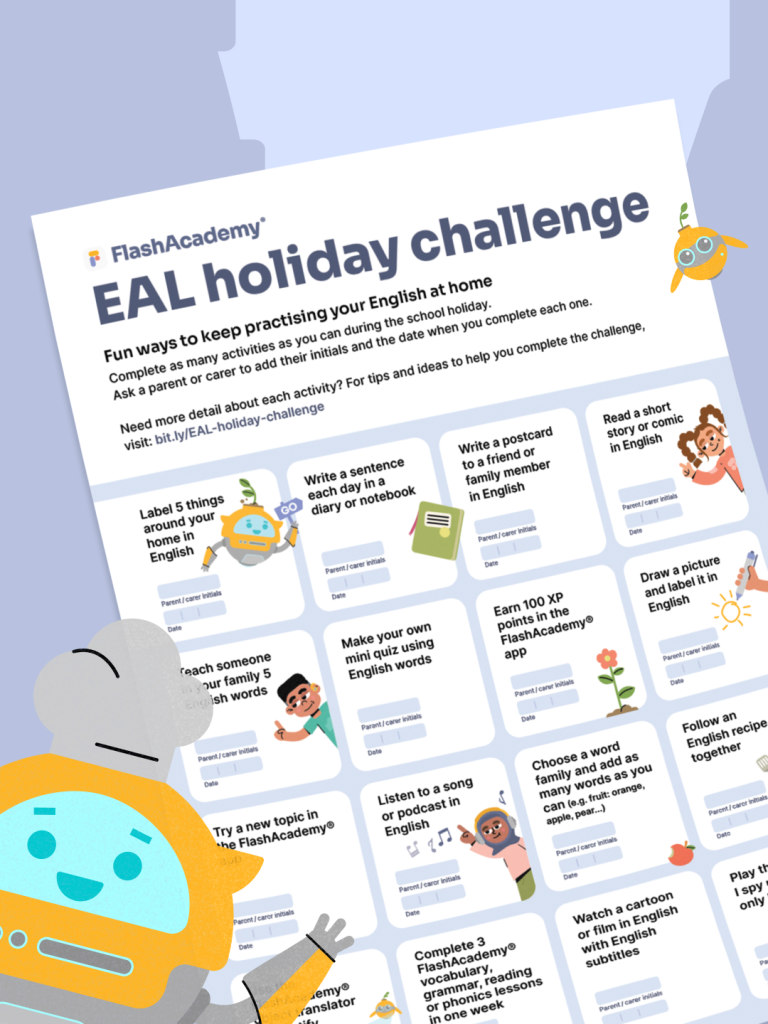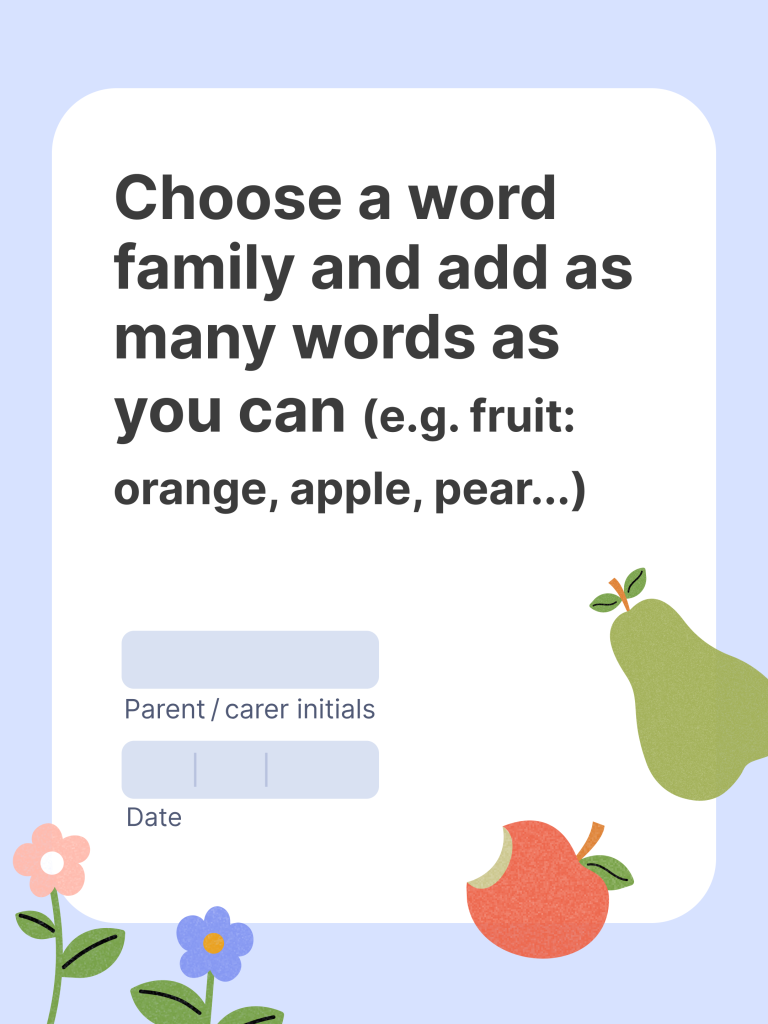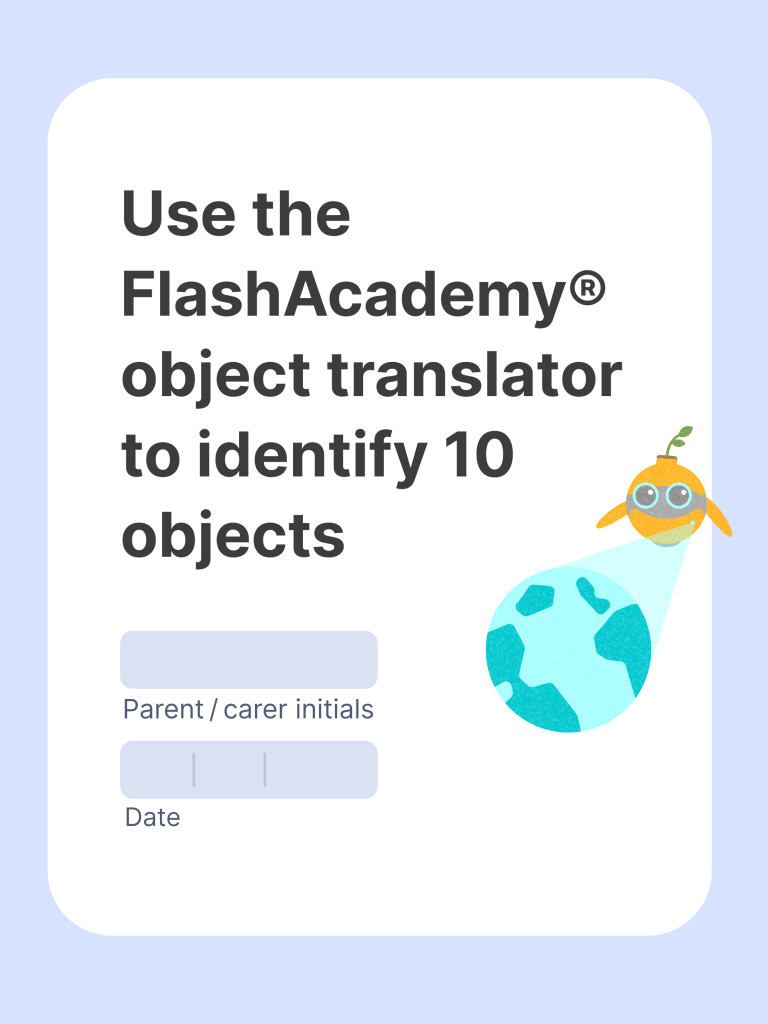


EAL holiday challenge – Fun English practice ideas

Every school holiday, many pupils with English as an Additional Language (EAL) risk losing some of the progress they have made with their English language learning. To help, we’ve created a motivating EAL holiday challenge that gives families simple ways to keep using and practising English together at home during the break.
The EAL school holiday challenge is designed for parents and carers to use with their child. It is a printable activity grid packed with fun, informal ideas that support everyday English language use. From watching a cartoon or film with subtitles to using the FlashAcademy® object translator around the home, each activity encourages meaningful language use without feeling like homework.
At the bottom of this page, each activity is listed with some additional information on how and why to complete it.

Why should families take part?
Support English learning over the break
Designed to keep EAL learners practising and progressing during the holiday.
Created for families
Simple to use at home, with minimal prep or supervision needed.
Encourages independence
Activities can be done solo or together, helping build confidence through everyday English use.
Supports classroom re-entry
Gives children something to talk about and share when they return to school.

What’s in the challenge?
Here are the 16 activities featured on the downloadable card, along with ideas for how to get started and why each one is helpful.
Label 5 things around your home in English
What to do:
- Choose five objects in your home, for example fridge, chair, or window.
- Write the English word clearly on a sticky note or piece of tape.
- Place the label on each object so your child sees it often.
- Repeat the word together when passing the object, for example: “This is the fridge”.
Why this helps:
- Seeing words in context helps your child learn and remember English.
- Labelling supports the connection between what they hear, see and read.
- It turns your home into a language-rich environment, giving steady, easy exposure without quizzes.
Write a sentence each day in a diary or notebook
What to do:
- Each day, ask your child to write a simple sentence like I played football today, I ate an apple, or It is sunny.
- They should write the date at the top of the page to encourage more entries.
- Encourage them to spell the words themselves and only help if necessary.
Why this helps:
- Builds daily writing habit, which boosts confidence and fluency over time.
- Helps learners practice grammar, spelling and sentence structure in a low-stress way .
- Supports vocabulary growth as they write about everyday experiences.
Write a postcard to a friend or family member in English
What to do:
- Choose or make a postcard.
- Start with a greeting: Dear [Name], for example, Dear Grandma, or Dear Sanju.
- Help your child write a short message in English – just 2 to 3 sentences. They could say what they did, where they went, or what they’ve learned during the holidays. For example: I visited the beach. Or, I learned new words.
- Finish with From [Child’s name], for example, From Anika.
- Post it or hand deliver it when home.
Why this helps:
- Writing to a real person gives children a purpose and it makes writing feel meaningful and fun.
- It helps build a child’s writing confidence, especially beginners, because it’s short and personal .
- Postcards or letters are easier than long writing tasks and bring joy through connection, while helping with spelling and sentence structure
Read a short story or comic in English
What to do:
- Choose a short story or comic with pictures.
- Read it together with your child.
- Pause to talk about pictures. Ask questions like, “What is happening here?” or “What does this word mean?”
Why this helps:
- Pictures give clues to help children understand words and the story.
- Reading together lets you support your child gently, helping them feel confident.
- Stories build vocabulary and help with reading skills in a fun way .
Teach someone in your family 5 English words
What to do:
- Ask your child to pick five new English words they have learned.
- Ask your child to explain each word’s meaning to a family member or friend with a simple sentence if possible, for example: Mum likes apples.
- Encourage your child to talk slowly and clearly and to show how the word is used.
Why this helps:
- Teaching boosts memory — explaining new words helps strengthen working memory and embeds the words more deeply.
- Learners engage more deeply when they know someone else will learn from them.
- Confidence grows as children see themselves helping others and using their new English skills successfully.
Make your own mini quiz using English words
What to do:
- Help your child pick a topic, for example colours, animals or food.
- They write 3–5 simple questions in English, for example: What colour is the sky? or How many legs does a cat have?
- Ask a sibling or adult to answer the questions. Your child checks the answers and gives a sticker or tick for each correct reply.
Why this helps:
- Quizzes use active recall, which improves memory better than just reading.
- It lets the child see what they remember and learn from mistakes.
- Quizzing boosts confidence and motivation, especially when they do well.
- It builds critical thinking and language use, not just vocabulary learning.
Earn 100 XP points on the FlashAcademy® app
What to do:
- Open the FlashAcademy® app and work through short lessons or games.
- Keep completing activities until you reach 100 XP points.
- You can check your XP score in the app.
Why this helps:
- XP (Experience Points) are like small rewards for each lesson – you earn points for completing each activity.
- Working towards 100 XP encourages your child to use the app regularly instead of doing everything in one session.
- This makes learning feel like a game and earning points motivates ongoing practice and progress.
Draw a picture and label it in English
What to do:
- Give your child paper and pens, pencils or crayons.
- Ask them to draw something simple, like their family, house, favourite toy or a meal.
- Help your child write English labels for parts of their drawing, for example mummy, door, table, ice cream.
- They can then say each English word out loud as they point to it.
Why this helps:
- Drawing helps children understand and remember new words because it connects images with English vocabulary.
- When learners themselves create visuals and labels, it makes new language feel meaningful and personal.
- Seeing their own drawings with labels builds confidence and supports their journey in learning English
Try a new topic in the FlashAcademy® app
What to do:
- Open the FlashAcademy® app.
- Choose a topic that interests your child, for example, School, Clothes, or Feelings.
- Complete lessons and activities in that topic until your child feels confident.
Why this helps:
- Learning words grouped by topic helps children make connections between related vocabulary, making it easier to remember and use them.
- When learners pick topics they care about, they’re naturally more motivated.
- FlashAcademy® uses images and sounds to support learning, making it easier for children to understand and remember new words.
Listen to a song or podcast in English
What to do:
- Pick a short song or podcast episode in English, ideally one that’s simple and clear.
- While listening, you or your child can note down a few new words, or try to sing along to the chorus.
- If it’s a podcast, pause occasionally and ask questions like: What was that sentence? or What new word did you hear?
- Replay the song or podcast once or twice to help understanding.
Why this helps:
- Listening to English helps build your child’s vocabulary and pronunciation, even outside class.
- Hearing English naturally through songs or stories exposes them to real conversations and rhythms of English speech.
- It’s easy and flexible: they can listen while walking, cleaning or relaxing, making English part of the daily routine
Choose a word family and add as many words as you can (eg fruit: orange, apple, pear…)
What to do:
- Pick a theme or starting word, such as fruit, play, or happy.
- Brainstorm and write down as many words as you know that fit the category.
- For fruit, you might list: orange, apple, pear, banana, grape.
- You can write this as a list, draw it as a mind map with the theme word in the middle of a page or even draw images as well as writing the words.
Why this helps:
- Studying word families (words that share the same root or theme) helps children see patterns in English, making spelling and vocabulary easier to learn.
- This supports understanding and remembering new words by grouping them meaningfully.
- It strengthens spelling and vocabulary skills, since knowing one family member gives clues to others
Follow an English recipe together
What to do:
- Find a simple recipe in English like smoothies, sandwiches, brownies or pancakes.
- Identify the ingredients and tools needed from the recipe and get them all together.
- Read each step aloud with your child, one at a time.
- Let your child help with tasks they can do safely: measuring, mixing, spreading.
- As you cook, use English for food names (banana), actions (stir), and measurements (grams, spoon).
Why this helps:
- Cooking together teaches English vocabulary for ingredients, kitchen items and actions in a real, hands‑on way.
- It involves following instructions step by step, which supports reading skills and concentration.
- Measuring ingredients shows English numbers and fractions in action, building practical maths and language skills.
- Cooking together supports healthy eating, confidence and family bonding – all while naturally using English
Use the FlashAcademy® object translator to identify 10 objects
What to do:
- Open the FlashAcademy® app on a smartphone or tablet.
- Tap the camera icon to activate the object translator.
- Find 10 objects at home or outside.
- Point the camera at each item, take a picture and watch the screen translate and say the English word aloud.
- Repeat the English word together as each object appears.
Why this helps:
- The object translator shows both the picture and spoken word in English, helping learners connect real items to language.
- It works anywhere – at home, the park, or on a walk – making learning natural and contextual .
- Hearing the pronunciation and seeing the translation helps with listening, speaking and vocabulary building all at once
Complete 3 FlashAcademy® lessons in one week
What to do:
- Open the FlashAcademy® app and log in.
- Choose one short lesson each day (e.g. 5–10 minutes), until you’ve done three in total this week. You can find lessons under themes like At Home or Food & Drink.
- For younger children, select phonics lessons to practise sounds and simple words.
Why this helps:
- Keeps children practising English regularly, rather than all at once.
- Helps them learn new vocabulary and topics.
- Builds a good habit of studying a little every day.
Watch a cartoon or film in English with English subtitles
What to do:
- Pick a cartoon or film your child already enjoys and play it in English.
- Turn on English subtitles (captions in the same language as the audio).
- Watch together, pausing if needed. You could ask your child to repeat a phrase or write down a new word they liked.
Why this helps:
- Seeing words while hearing them helps your child match the sound and spelling, improving listening and reading.
- Subtitles help the listener to hear words clearly, even when accents or fast speech are hard to hear .
- This builds new vocabulary naturally and encourages confidence through familiar content.
Play the game I spy using only English
What to do:
- One person looks around and picks an object that everyone can see, for example car.
- They say: I spy with my little eye something beginning with… and say the first letter of the object, for example, C.
- Everyone else takes turns guessing what it is.
- When someone guesses correctly, they become the next one to play I spy.
Why this helps:
- This simple guessing game helps your child learn and practise new vocabulary.
- It encourages them to use English to listen, think and speak.
- You can play it anywhere – at home, in the car, or while you walk – making English a natural part of everyday life.
